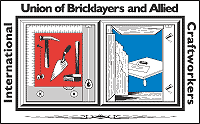Related Research Articles

The United Brotherhood of Carpenters and Joiners of America, often simply the United Brotherhood of Carpenters (UBC), was formed in 1881 by Peter J. McGuire and Gustav Luebkert. It has become one of the largest trade unions in the United States, and through chapters, and locals, there is international cooperation that poises the brotherhood for a global role. For example, the North American Chapter has over 520,000 members throughout the continent.

The International Union of Bricklayers and Allied Craftworkers (BAC) is a labor union in the United States and Canada which represents bricklayers, restoration specialists, pointers/cleaners/caulkers, stonemasons, marble masons, cement masons, plasterers, tile setters, terrazzo mechanics, and tile, marble and terrazzo finishers. The union is an affiliate of the AFL–CIO and its Building and Construction Trades Department. It is also affiliated with the Canadian Labour Congress in Canada.

James Duncan was a Scottish American union leader, and president of the Granite Cutters' International Association from 1885 until his death in 1928. He was an influential member of the American labor movement, helping to co-found the American Federation of Labor.
The International Paving Cutters' Union of the United States of America and Canada was a trade union affiliated with the American Federation of Labor with members in Canada and the United States. A craft union, its members claimed "sole jurisdiction over the cutting of stone paving blocks, which includes: Flanged, beveled, and all stone blocks used in courts, alleys, yards, or streets for paving; also stone blocks and rough ashlar used for building purposes on which paving-cutters' tools are used."
The Barbers, Beauticians and Allied Industries International Association (BBAIIA) was a labor union representing workers in the personal grooming industry in the United States and Canada.
The International Stereotypers' and Electrotypers' Union (ISEU) was a labor union representing workers in two related trades in the United States and Canada.
The United Wall Paper Craftsmen of North America (UWPC) was a labor union representing wallpaper cutters and printers in the United States and Canada.
The International Brotherhood of Pulp, Sulphite, and Paper Mill Workers (IBPSPMW) was a labor union representing workers involved in making paper in the United States and Canada.
The United Brick and Clay Workers of America (UBCWA) was a labor union representing brickmakers, clay and terracotta workers and clay miners in the United States.
The United Glass and Ceramics Workers of North America (UGCWNA) was a labor union representing workers in several related industries in the United States and Canada.
The International Brotherhood of Pottery and Allied Workers (IBPAW) was a labor union representing workers in the pottery industry in the United States and Canada.
The United Cement, Lime and Gypsum Workers' International Union (UCLG) was a labor union representing workers involved in processing building supplies in the United States.
The Window Glass Cutters' League of America (WCGLA) was a labor union representing workers involved in making flat glass in the United States.
The American Flint Glass Workers' Union (AFGWU) was a labor union representing workers involved in making glassware and related goods in the United States and Canada.
The International Jewelry Workers' Union (IJWU) was a labor union representing workers involved in making jewelry in the United States and Canada.
The Metal Polishers', Buffers', Platers' and Allied Workers' International Union (MPBP) was a labor union representing metal workers in the United States and Canada.
The United National Association of Post Office Clerks (UNAPOC) was a labor union representing clerks working in the post office in the United States.
The Laundry Workers' International Union (LWIU) was a labor union representing laundry workers in the United States.
The American Federation of Grain Millers (AFGM) was a labor union representing workers in the milling trade in the United States.
The International Union of Wood, Wire and Metal Lathers (WWML) was a labor union representing workers involved in erecting lath, plasterboard and flooring in the United States and Canada.
References
- 1 2 Handbook of American Trade Unions (PDF). Washington, D.C.: United States Department of Labor. 1926. Retrieved 24 April 2022.
- 1 2 3 4 "Inactive Organizations" (PDF). UMD Labor Collections. University of Maryland. Retrieved 18 April 2022.
- ↑ Directory of National and International Labor Unions in the United States (PDF). Washington, D.C.: United States Department of Labor. 1957. Retrieved 18 April 2022.
- ↑ Directory of National Unions and Employee Associations (PDF). Washington DC: United States Department of Labor. 1980. Retrieved 3 May 2022.